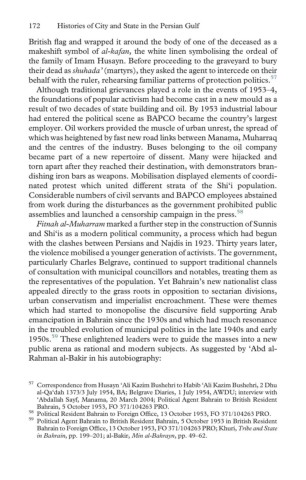Page 192 - Histories of City and State in the Persian Gulf_Neat
P. 192
172 Histories of City and State in the Persian Gulf
British flag and wrapped it around the body of one of the deceased as a
makeshift symbol of al-kafan, the white linen symbolising the ordeal of
the family of Imam Husayn. Before proceeding to the graveyard to bury
their dead as shuhada’ (martyrs), they asked the agent to intercede on their
behalf with the ruler, rehearsing familiar patterns of protection politics. 57
Although traditional grievances played a role in the events of 1953–4,
the foundations of popular activism had become cast in a new mould as a
result of two decades of state building and oil. By 1953 industrial labour
had entered the political scene as BAPCO became the country’s largest
employer. Oil workers provided the muscle of urban unrest, the spread of
which was heightened by fast new road links between Manama, Muharraq
and the centres of the industry. Buses belonging to the oil company
became part of a new repertoire of dissent. Many were hijacked and
torn apart after they reached their destination, with demonstrators bran-
dishing iron bars as weapons. Mobilisation displayed elements of coordi-
nated protest which united different strata of the Shi‘i population.
Considerable numbers of civil servants and BAPCO employees abstained
from work during the disturbances as the government prohibited public
assemblies and launched a censorship campaign in the press. 58
Fitnah al-Muharram marked a further step in the construction of Sunnis
and Shi‘is as a modern political community, a process which had begun
with the clashes between Persians and Najdis in 1923. Thirty years later,
the violence mobilised a younger generation of activists. The government,
particularly Charles Belgrave, continued to support traditional channels
of consultation with municipal councillors and notables, treating them as
the representatives of the population. Yet Bahrain’s new nationalist class
appealed directly to the grass roots in opposition to sectarian divisions,
urban conservatism and imperialist encroachment. These were themes
which had started to monopolise the discursive field supporting Arab
emancipation in Bahrain since the 1930s and which had much resonance
in the troubled evolution of municipal politics in the late 1940s and early
59
1950s. These enlightened leaders were to guide the masses into a new
public arena as rational and modern subjects. As suggested by ‘Abd al-
Rahman al-Bakir in his autobiography:
57
Correspondence from Husayn ‘Ali Kazim Bushehri to Habib ‘Ali Kazim Bushehri, 2 Dhu
al-Qa‘dah 1373/3 July 1954, BA; Belgrave Diaries, 1 July 1954, AWDU; interview with
‘Abdallah Sayf, Manama, 20 March 2004; Political Agent Bahrain to British Resident
Bahrain, 5 October 1953, FO 371/104263 PRO.
58
Political Resident Bahrain to Foreign Office, 13 October 1953, FO 371/104263 PRO.
59
Political Agent Bahrain to British Resident Bahrain, 5 October 1953 in British Resident
Bahrain to Foreign Office, 13 October 1953, FO 371/104263 PRO; Khuri, Tribe and State
in Bahrain, pp. 199–201; al-Bakir, Min al-Bahrayn, pp. 49–62.

